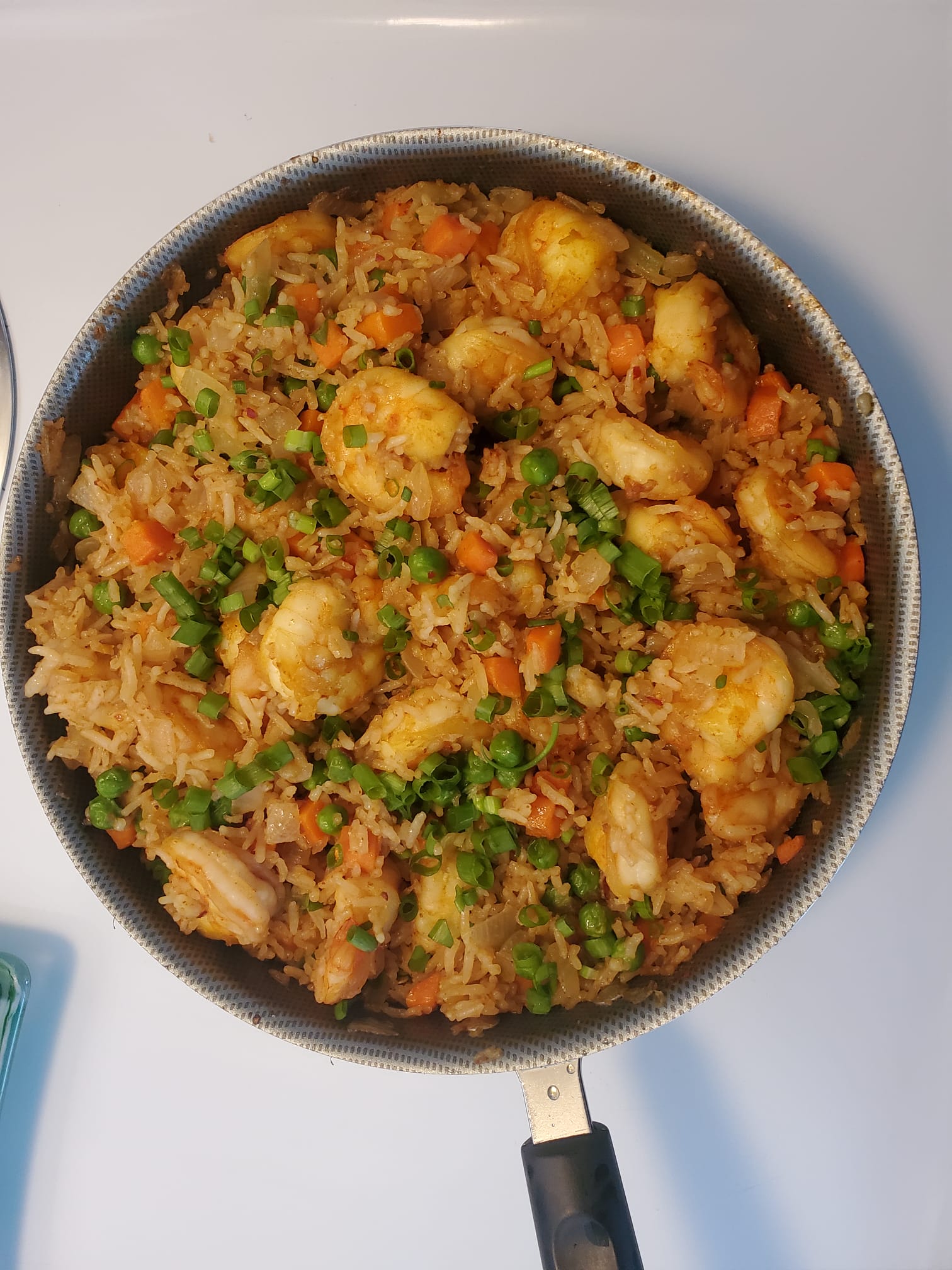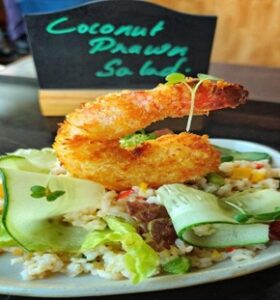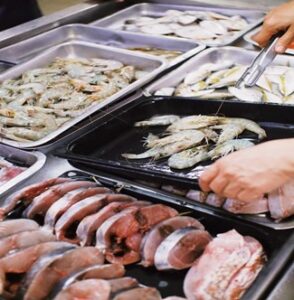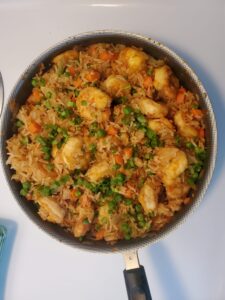
Whip Up Restaurant-Worthy Shrimp Fried Rice at Home with Our Step-by-Step Guide!
This Shrimp fried rice comprehensive 3000-word recipe guide will empower work-from-home moms and cooking enthusiasts to create restaurant-worthy shrimp fried rice with confidence and finesse. You will learn how to Cook Shrimp Fried Rice like a Pro Chef at home. Each section provides detailed instructions, expert tips, and practical advice to ensure a successful culinary journey.
I. Introduction
II. Essential Ingredients and Tools
III. Preparation and Precooking
IV. The Art of Stir-Frying
V. Flavorful Seasoning and Saucing
VI. Restaurant-Quality Presentation
VII. Variations and Customizations
VIII. Troubleshooting and Tips
IX. Frequently Asked Questions
X. Conclusion
Introduction

Imagine the irresistible aroma of your favorite restaurant’s shrimp fried rice wafting through your kitchen. Picture the delighted smiles around the dinner table as you unveil a piping hot, perfectly cooked dish. You don’t have to be a professional chef to make this happen; you just need our step-by-step guide.
If you’re a busy mom like me, you’ll appreciate the joy of creating a restaurant-worthy meal right in your own home. This guide is your ticket to becoming a shrimp fried rice master, even if you’ve never tried your hand at it before.
We’ll break down the process into simple, easy-to-follow steps, from selecting the best shrimp and rice to mastering the art of stir-frying. We’ll explore essential ingredients, tools, and techniques that will make your homemade shrimp fried rice taste just as good as your favorite takeout.
So, grab your apron, roll up your sleeves, and let’s embark on a culinary adventure. By the end of this guide, you’ll have the skills and confidence to whip up shrimp fried rice that’s not just delicious but also a source of pride. Say goodbye to restaurant bills and hello to restaurant-quality meals right at home. Let’s get started!
II. Essential Ingredients and Tools

Before we dive into the world of cooking restaurant-worthy shrimp fried rice, it’s crucial to assemble the right ingredients and tools. These are the building blocks of your culinary masterpiece. Let’s take a closer look:
A. Selecting the Perfect Shrimp
When it comes to shrimp, freshness is key. Opt for:
Fresh or Frozen Shrimp: Fresh shrimp should have a mild ocean scent, while frozen shrimp should be odorless. Either option works; just choose what’s convenient for you.
Shrimp Sizes and Varieties: Common options include small, medium, and large. Larger shrimp are easier to work with and provide a meatier texture. Choose the size that suits your preferences.
B. Rice: The Foundation of Great Fried Rice
Rice is the heart of any fried rice dish. You’ll need:
Long-Grain Rice: Jasmine or Basmati rice works well. For 4 servings, measure 2 cups of uncooked rice.
Proper Rice Preparation: Rinse the rice thoroughly until the water runs clear before cooking. Cook the rice a day ahead and refrigerate it for the best results. This reduces moisture content and prevents clumping. Unlike in Mayonnaise Garlic Fried Rice where you can use hot rice, this recipe requires cold rice.
C. Seasonings and Sauces
Flavor is the secret to great shrimp fried rice. Gather these essentials:
Soy Sauce: Opt for low-sodium soy sauce, starting with 2-3 tablespoons.
Oyster Sauce: Add depth of flavor with 1-2 tablespoons of oyster sauce.
Aromatics: Prepare 2-3 cloves of garlic, minced, and a tablespoon of fresh ginger, finely grated. Additionally, slice 2-3 scallions.
D. Essential Cooking Equipment
A well-equipped kitchen ensures a smooth cooking experience. You’ll need:
Wok or Skillet: A wok is traditional, but a large skillet will also work. Make sure it’s deep enough to contain all the ingredients comfortably.
High Heat: Use a stovetop that provides high heat for quick and even cooking.
Other Utensils: Have a wooden spoon or spatula for stirring and flipping. Additionally, grab a sharp knife for chopping, and a cutting board for preparation work.
By starting with the right ingredients and tools, you’re setting yourself up for success. These basics will pave the way for a restaurant-worthy shrimp fried rice that will leave your family asking for seconds. Next, we’ll dive into the preparation and pre-cooking steps to ensure everything is prepped and ready to go.
III. Preparation and Precooking

Preparing and precooking your ingredients is the foundation of a flawless shrimp fried rice dish. Let’s delve into these essential steps:
A. Cleaning and Deveining Shrimp
Selecting Shrimp: Start by choosing fresh or thawed frozen shrimp. Remove the shells, leaving the tails intact if you prefer. Using a small, sharp knife, make a shallow cut along the back of each shrimp to expose the vein. Gently remove it by rinsing under cold water.
Pat Dry: After removing the veins, pat the shrimp dry with paper towels. Excess moisture can lead to a watery stir-fry.
B. Marinating Shrimp for Flavor

Flavorful Marinade: Enhance the taste of your shrimp by marinating them. Combine 2 tablespoons of soy sauce and a teaspoon of minced garlic. Toss the cleaned and dried shrimp in this mixture and let them sit for 10-15 minutes. This infuses them with a savory umami flavor.
C. Cooking and Cooling the Rice
Cooking Rice: Refer to the rice package instructions for the ideal water-to-rice ratio. Typically, use 1.5 to 2 cups of water for every cup of rice. Bring water to a boil, add rice, reduce heat, and cover. Simmer for 18-20 minutes or until tender. Spread cooked rice on a baking sheet to cool thoroughly.
Chilling Rice: Refrigerate the cooked rice for at least a few hours, or overnight if possible. Cold rice ensures each grain remains separate during stir-frying, preventing clumping.
D. Prepping Aromatics and Vegetables
Mince Garlic and Ginger: Finely mince 2-3 cloves of garlic and grate a tablespoon of fresh ginger. These aromatic ingredients will add depth to your dish.
Chop Scallions and Vegetables: Slice 2-3 scallions, separating the white and green parts.
Dice your choice of vegetables – common additions include carrots, peas, bell peppers, and corn. Aim for bite-sized pieces for quick and even cooking.
By taking the time to clean, marinate, and precook your ingredients, you’re laying the groundwork for a sensational shrimp fried rice. These steps ensure that each element is ready to harmonize in the wok or skillet, resulting in a symphony of flavors in your final dish.
In the next section, we’ll delve into the art of stir-frying, where the magic truly begins.
IV. The Art of Stir-Frying
Now that your ingredients are prepared and ready, it’s time to explore the heart of shrimp fried rice – the art of stir-frying. Don’t be intimidated; it’s simpler than it seems.
A. Proper Wok/Skillet Heating
High Heat: Begin by placing your wok or skillet on high heat. A hot cooking surface is essential for a successful stir-fry. If you’re unsure if it’s hot enough, sprinkle a few drops of water onto the pan – they should sizzle and evaporate instantly.
B. Oil Selection and Heat Management
Choosing the Right Oil: Opt for oils with high smoke points like vegetable oil, canola oil, or peanut oil. Add 2-3 tablespoons of oil to your hot wok or skillet.
Evenly Coating the Pan: Swirl the oil to ensure it coats the bottom evenly. This prevents sticking and promotes even cooking.
C. Cooking Shrimp to Perfection
Shrimp in the Pan: Carefully add your marinated shrimp to the hot oil. Arrange them in a single layer to ensure even cooking

Quick Cook: Shrimp cook swiftly, taking only 1-2 minutes per side. Flip them when they turn pink and opaque on one side. Remove them from the pan once they’re uniformly cooked.
D. Sautéing Aromatics and Vegetables
Aromatics First: In the same pan, add your minced garlic, grated ginger, and the white parts of the scallions. Stir-fry for about 30 seconds until fragrant.
Adding Vegetables: Toss in your diced vegetables. Stir-fry for 2-3 minutes, allowing them to soften and become vibrant.
E. Incorporating Eggs: The Technique
Creating Space: Push the cooked ingredients to one side of the pan to make room for the eggs.
Scramble Eggs: Crack 2-3 eggs into the open space and scramble them until just set.
F. Combining Rice and Stir-Fry
Introduce Chilled Rice: Add the chilled, cooked rice to the pan. Use your spatula to break up any clumps and evenly distribute it among the other ingredients.
Stir-Fry Unites All: Stir-fry everything together for 3-4 minutes. The rice should absorb the flavors of the other ingredients, and each grain should glisten with the sauce.
G. Mastering the Stir-Fry Process
Frequent Stirring: Keep stirring the ingredients continuously to prevent sticking and ensure even cooking.

Whip Up Restaurant-Worthy Shrimp Fried Rice at Home with Our Step-by-Step Guide!
Seasoning: Drizzle 2-3 tablespoons of soy sauce and 1-2 tablespoons of oyster sauce over your stir-fry. Continue to stir-fry for an additional 2-3 minutes, allowing the sauce to coat the ingredients.
By mastering these simple steps, you’re on your way to creating a shrimp fried rice that’s as delectable as it is satisfying. The art of stir-frying relies on quick cooking and the right sequence of steps, making it accessible for every home cook.
Next, we’ll explore the secrets of flavoring your dish and achieving that restaurant-quality taste in your homemade shrimp fried rice.
V. Flavorful Seasoning and Saucing
Now that your shrimp fried rice is taking shape, it’s time to infuse it with mouthwatering flavors. Here’s how to achieve a delectable taste sensation:
A. Balancing Saltiness with Soy Sauce
Controlled Seasoning: Begin by adding 2-3 tablespoons of soy sauce to your stir-fry. It’s essential to start with a moderate amount and adjust to taste later.
Taste and Adjust: After adding soy sauce, give your dish a gentle stir and taste a small portion. If it needs more saltiness, add a bit more soy sauce. Remember, it’s easier to add more later than to remedy an overly salty dish.
B. The Richness of Oyster Sauce
Adding Depth: Incorporate 1-2 tablespoons of oyster sauce into your stir-fry. This savory condiment enhances the overall richness and umami of the dish.
Balancing Act: As with soy sauce, taste and adjust as needed. The goal is to achieve a harmonious balance of flavors.
C. Additional Seasonings and Spices
Customize to Taste: Depending on your preferences, you can add a pinch of white pepper for a mild kick or a dash of red pepper flakes for heat.
A Touch of Sweetness: If you prefer a touch of sweetness, consider adding a teaspoon of sugar or honey. This can round out the flavors and create a pleasant contrast.
D. The Secret Ingredient: MSG (optional)
MSG: Monosodium glutamate, commonly known as MSG, is an optional ingredient that can enhance the savory “umami” flavor of your dish. If you choose to use it, a small pinch (about 1/4 teaspoon) can go a long way.
Be Mindful: Some individuals may be sensitive to MSG, so use it sparingly and according to your preferences.
E. Adjusting Seasonings to Taste
Taste and Tweak: The key to a well-seasoned shrimp fried rice is tasting as you go. After incorporating your chosen seasonings, take a moment to sample your creation. Adjust the soy sauce, oyster sauce, or other seasonings as necessary to achieve the perfect balance of flavors.
Remember Your Audience: If you’re serving a variety of palates, consider offering soy sauce or hot sauce on the side so that each diner can customize their plate to their liking.
By carefully seasoning your shrimp fried rice, you’ll elevate it from ordinary to extraordinary. The interplay of salty, savory, and subtle sweet notes will make each bite a delightful experience.
In our next section, we’ll explore the finer points of presentation, ensuring your homemade dish not only tastes fantastic but also looks restaurant-worthy.
VI. Restaurant-Quality Presentation
Creating a visually appealing plate of shrimp fried rice is the final touch that transforms a homemade meal into a restaurant-worthy delight. Here’s how to elevate your presentation:

A. The Importance of Texture and Color
Texture Variety: Aim for a balance of textures. Your shrimp fried rice should include tender shrimp, fluffy rice, and crisp-tender vegetables. This variety not only pleases the palate but also the eye.
Color Contrast: Incorporate a mix of colorful vegetables like red bell peppers, green peas, and vibrant orange carrots. The visual appeal of your dish is enhanced by the contrast in colors.
B. Garnishing Like a Pro
Fresh Herbs: Sprinkle some fresh herbs, such as chopped cilantro or parsley, over the top. This adds a burst of color and freshness.
Sesame Seeds: A light dusting of toasted sesame seeds not only imparts a delightful nutty flavor but also provides a beautiful visual contrast.
Lime or Lemon Wedges: Placing a few citrus wedges on the plate adds a pop of color and offers a bright, tangy garnish.
Thinly Sliced Scallions: Reserve some of the green parts of the scallions you chopped earlier and sprinkle them on top. Their vibrant green color provides a lovely finishing touch.
C. Serving Suggestions and Accompaniments
Use Elegant Serve-ware: Opt for elegant plates or bowls that complement the colors of your dish. A clean, white plate often works well as a backdrop for the vibrant ingredients.
Individual Servings: Consider serving the shrimp fried rice in individual portions. This not only looks sophisticated but also makes it easier for everyone to enjoy.
Side Condiments: Offer additional condiments like soy sauce, chili sauce, or hoisin sauce in small dipping bowls on the side. This allows your guests to customize their meal to their liking.
Edible Decor: Edible flowers, microgreens, or small edible arrangements can add an extra level of sophistication to your presentation.
Remember, presentation is about appealing to the eyes as much as it is about pleasing the taste buds. Taking a little extra time to garnish and present your shrimp fried rice beautifully can make the dining experience feel special and restaurant-quality.
With these presentation tips, you’ll not only serve a delicious meal but also create a dining experience that’s worthy of any restaurant. Your family and guests will be impressed not only by the taste but also by the visual feast you’ve prepared.
VII. Variations and Customizations in your Shrimp Fried Rice
Variety is the spice of life, and your shrimp fried rice can be tailored to suit your preferences or dietary needs. Here are several ways to customize this classic dish that I used in my other recipes.
A. Adding Extra Protein: Chicken, Beef, or Tofu
Chicken: Slice boneless, skinless chicken breast or thighs into bite-sized pieces and marinate them similarly to the shrimp. Cook the chicken until it’s no longer pink, then proceed with the stir-fry as usual.
Beef: Thinly slice beef, such as flank or sirloin, against the grain. Marinate it or season it with soy sauce and a touch of sugar. Stir-fry it briefly before adding the other ingredients. Check out how to cut beef and marinate it well before cooking here.
Tofu: For a vegetarian or vegan option, use extra-firm tofu. Cut it into cubes and pan-fry until golden brown before adding it to the stir-fry. Tofu soaks up flavors beautifully.
B. Vegetarian and Vegan Options instead of Shrimp
Swap the Protein: Skip the shrimp and add more vegetables or tofu for a vegetarian version. Soy-based meat alternatives are also an option.
Eggplant or Mushroom: Incorporate eggplant or mushrooms for a meaty texture and earthy flavor. Sauté them until tender before adding to the rice. See how you can easily saute’ mushrooms in this recipe.
C. Dietary Modifications and Allergen Considerations
Gluten-Free: Use gluten-free soy sauce or tamari to make the dish gluten-free. Check ingredient labels for any hidden sources of gluten.
Low-Sodium: Reduce the sodium content by using low-sodium soy sauce or adjusting the amount of soy sauce used. You can also opt for a salt-free seasoning blend.
Allergen-Free: If you have allergies, ensure your chosen sauces and condiments are free from allergens like peanuts or shellfish. Always read labels carefully.
D. Fusion Flavors and International Twists for Shrimp Fried Rice
Thai Influence: Add Thai flavors by using fish sauce, Thai basil, and a squeeze of lime for a Thai-inspired shrimp fried rice.
Indian Fusion: Infuse Indian flavors with spices like cumin, coriander, and turmeric. Garnish with fresh cilantro and serve with a side of raita.
Chinese-Style: Make it more akin to Yangzhou fried rice by incorporating BBQ pork or Chinese sausage. Top with a sprinkle of sesame oil for authenticity. Check out this Chinese Style Stir Fry Snow Peas if you would like to incorporate a Chinese side dish in your presentation.
Hawaiian Touch: Create a Hawaiian vibe by adding pineapple chunks and a dash of teriyaki sauce for a sweet and savory twist.
Customizing your shrimp fried rice allows you to cater to different tastes and dietary requirements. Whether you’re a meat lover, vegetarian, or looking for international flavor fusion, these variations offer endless culinary possibilities.
Feel free to get creative and experiment with different ingredients and flavors. Shrimp fried rice is a versatile canvas ready for your personal touch.
VIII. Troubleshooting and Tips Shrimp Fried Rice
Even the most experienced cooks encounter challenges from time to time. Here are some common issues you might face while making shrimp fried rice and tips to overcome them:
A. Common Mistakes and How to Avoid Them
Sticky Rice: If your rice turns out sticky or clumpy, it’s likely due to excess moisture. Ensure the rice is thoroughly cooled and consider using day-old rice. If it’s too late, you can spread the rice on a baking sheet and gently break up the clumps with a fork.
Soggy Stir-Fry: An overly wet stir-fry can result from overcrowding the pan or failing to pat dry the shrimp and vegetables. Cook in batches if needed, and use paper towels to blot any excess moisture.
Overcooked Shrimp: Shrimp can become tough and rubbery if overcooked. Keep a close eye on them – they should turn pink and opaque. Remove them from the pan as soon as they’re done to avoid overcooking.
B. Achieving the Perfect Shrimp Texture
Consistent Sizing: To ensure even cooking, aim for uniform shrimp sizes. If you are using different sizes, cook the larger ones first and add the smaller ones later.
Marinating Time: Don’t marinate the shrimp for too long – 10-15 minutes is sufficient. Over-marinating can cause the shrimp to become mushy.
C. Preventing Rice Clumps
Chilled Rice: Ensure your rice is properly chilled before stir-frying. Warm rice tends to clump together, while cold rice remains separate.
Stirring Technique: When incorporating the rice into the stir-fry, use a gentle folding motion rather than vigorous stirring. This helps prevent rice breakage and clumping.
D. Quick Fixes for Over-seasoned or Overcooked Dishes
Over-seasoned: If your dish is too salty, try adding more rice or additional unsalted ingredients like steamed broccoli or unsalted nuts. You can also balance the flavors with a squeeze of lemon or lime juice.
Overcooked Vegetables: If your vegetables are overcooked and mushy, remove them from the pan immediately. You can stir-fry fresh vegetables separately and then combine them with the rest of the dish.
Reheat with Care: When reheating leftovers, do it gently over low heat to avoid overcooking and making the dish even drier.
Remember, practice makes perfect. Don’t be discouraged by occasional mishaps – they’re part of the learning process. As you gain experience, you’ll become more adept at troubleshooting and creating flawless shrimp fried rice every time.
With these tips in mind, you’re well-equipped to tackle any challenges that may arise during your culinary journey. Enjoy the process of honing your skills and savoring the delicious results!
IX. Frequently Asked Questions
Can I use any type of rice for shrimp fried rice?
While long-grain rice like Jasmine or Basmati is commonly used, you can experiment with other varieties. Just be sure to cook and chill the rice beforehand for the best results.
Is it necessary to devein the shrimp?
Deveining shrimp is optional, but it’s recommended for a more visually appealing and enjoyable dining experience. It’s also a matter of personal preference.
Can I make shrimp fried rice ahead of time?
Yes, you can prepare shrimp fried rice in advance and refrigerate it for up to 2-3 days. Reheat it gently in a pan with a splash of water or broth to retain its texture and flavor.
Can I substitute ingredients in shrimp fried rice?
Absolutely! Shrimp fried rice is versatile, and you can swap proteins or vegetables to suit your taste. Just ensure they are cooked and seasoned properly.
How do I store leftover shrimp fried rice?
Store leftover shrimp fried rice in an airtight container in the refrigerator. It should be consumed within a few days to ensure freshness.
X. Conclusion
Congratulations, you’ve embarked on a culinary adventure and mastered the art of creating restaurant-worthy shrimp fried rice right in the comfort of your own home. Through this guide, we’ve taken you step by step, from selecting the perfect ingredients to achieving a visually appealing and palate-pleasing dish.
As you continue to hone your skills and experiment with variations, remember that the joy of cooking is not just in the delicious results but also in the journey itself. Shrimp fried rice is a versatile canvas ready for your personal touch, whether you’re a work-from-home mom looking for a quick weekday meal or a passionate home cook seeking to impress.
So, why wait? Put on your apron, gather your ingredients, and let your kitchen become the stage for your culinary creativity. Share your shrimp fried rice creations with family and friends, and savor the satisfaction of a meal well-prepared.
But this is just the beginning. The world of cooking is vast and exciting. Explore new recipes, experiment with flavors, and continue to expand your culinary repertoire. Whether it’s mastering other Asian dishes, exploring international cuisine, or simply enjoying the process of cooking, the world of flavors is yours to discover.
Thank you for joining us on this journey to create restaurant-quality shrimp fried rice at home. We hope you savor every bite and continue to explore the delicious
possibilities that await in your kitchen.
Do not forget to check out how to cook:
Also find out how to add more flavor like mayonnaise in fried rice here.
Bon Appétit, and happy cooking!
